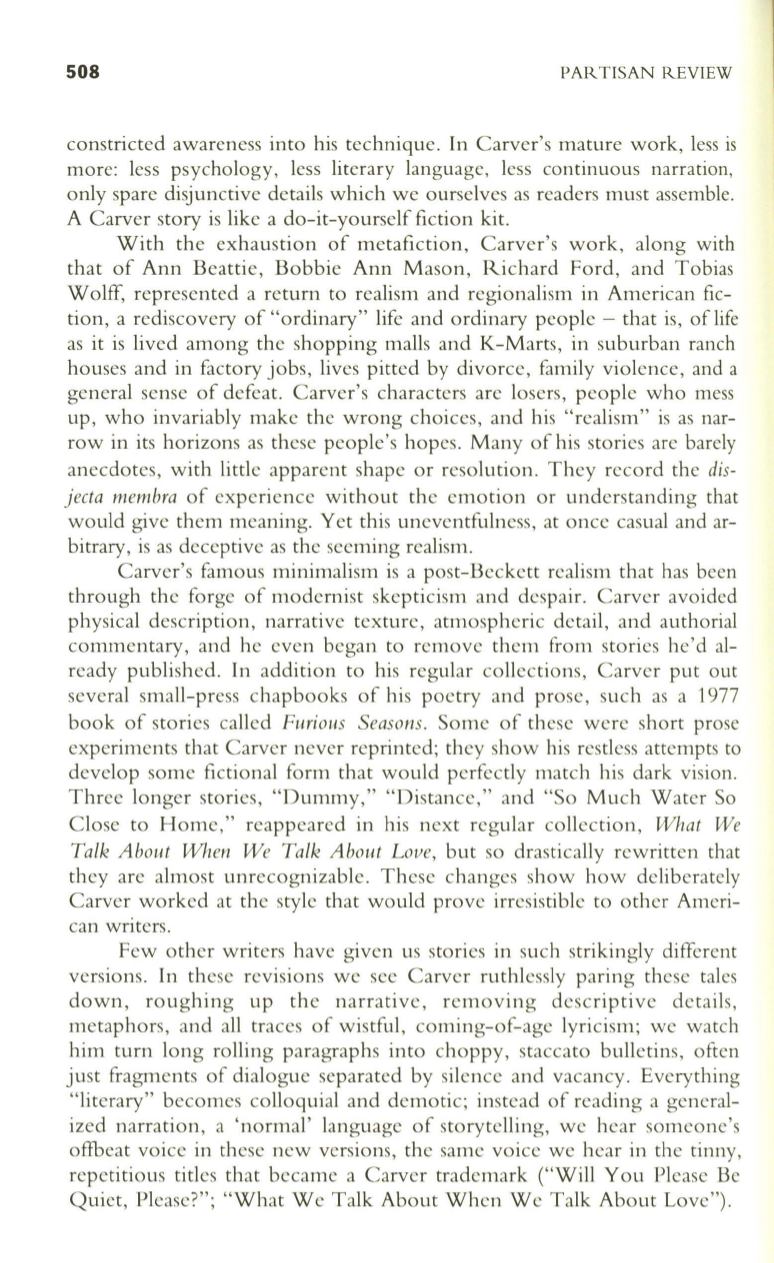
508
PARTISAN REVIEW
constricted awareness into his technique.
In
Carver's mature work, less is
more: less psychology, less literary language, less continuous narration,
only spare disjunctive details which we ourselves as readers must assemble.
A Carver story is like a do-it-yourself fiction kit.
With the exhaustion of metafiction, Carver's work, along with
that of Ann Beattie, Bobbie Ann Mason, Richard Ford, and Tobias
Wolff, represented a return to realism and regionalism in American fic–
tion, a rediscovery of "ordinary" life and ordinary people - that is, of life
as it is lived among the shopping malls and K-Marts, in suburban ranch
houses and in factory jobs, lives pitted by divorce, family violence, and a
general sense of defeat. Carver's characters are losers, people who mess
up, who invariably make the wrong choices, and his "realism" is as nar–
row in its horizons as these people's hopes. Many of his stories are barely
anecdotes, with little apparent shape or resolution. They record the
dis–
jecta membra
of experience without the emotion or understanding that
would give them meaning. Yet this uneventfulness, at once casual and ar–
bitrary, is as deceptive as the seeming realism.
Carver's famous minimalism is a post-Beckett realism that has been
through the forge of modernist skepticism and despair. Carver avoided
physical description, narrative texture, atmospheric detail, and authorial
commentary, and he even began to remove them from stories he'd al–
ready published.
In
addition to his regular collections, Carver put out
several small-press chapbooks of his poetry and prose, such as a 1977
book of stories called
Furious Seasons.
Some of these were short prose
experiments that Carver never reprinted; they show his restless attempts to
develop some fictional form that would perfectly match his dark vision.
Three longer stories, "Dummy," "Distance," and "So Much Water So
Close to Home," reappeared in his next regular collection,
What We
Talk About When We Talk About Love,
but so drastically rewritten that
they are almost unrecognizable. These changes show how deliberately
Carver worked at the style that would prove irresistible to other Ameri–
can writers.
Few other writers have given us stories in such strikingly different
versions.
In
these revisions we see Carver ruthlessly paring these tales
down, roughing up the narrative, removing descriptive detail s,
metaphors, and all traces of wistful, coming-of-age lyricism; we watch
him turn long rolling paragraphs into choppy, staccato bulletins, often
just fragments of dialogue separated by silence and vacancy. Everything
"literary" becomes colloquial and demotic; instead of reading a general–
ized narration , a 'normal' language of storytelling, we hear someone's
offbeat voice in these new versions, the same voice we hear in the tinny,
repetitious titles that became a Carver trademark ("Will You Please Be
Quiet, Please?"; "What We Talk About When We Talk About Love").


